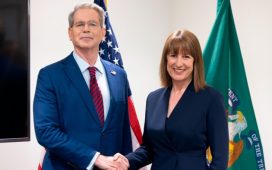SEA-AIR-SPACE NEWS: Unleashing Innovation Key to ‘Economic Battle’

iStock photo
NATIONAL HARBOR, Maryland — At the center of a world disrupted by climate change, technology and conflict, an economic battle rages, and harnessing innovation is the key to victory, said one Navy official.
Rear Adm. Lorin Selby, chief of Naval Research, spoke of a threat creeping through email traffic, banking transactions and ones and zeroes.
“I’m here to tell you that the world is in a place today where that is being threatened,” Selby said at the Navy League’s Sea-Air-Space exposition Apr. 4. “And for the first time in my life, it is truly threatened at a scale that I think we need to take action now.”
The nation needs to “double down” on three areas of technology to stay ahead, Selby said: computing, biotechnology and power and energy.
He highlighted biotechnology as an “incredibly exciting field” that will be “transformative.” In addition to dealing with pathogens, vaccine development and understanding brain cognition, it’s also understanding biofuels and engineering cells, he said.
The Defense Department recently released a Biomanufacturing Strategy, which Selby referenced as evidence of biotechnology’s growing importance. A Defense Department press release described the strategy as a guide for research efforts, industry partnerships and relationships with allies in a “rapidly developing technology field with significant implications for national security and economic competitiveness.”
“This is going to be big, folks,” Selby said. “China actually has a lead — we need to catch up.”
One hurdle hampering advancement in these areas is the dreaded “valley of death,” Selby said — the phase between development and deployment that ensnares ideas in bureaucracy and hoop-jumping before coming to fruition.
From lab to prototype, prototype to product and product to scale, scaling needs to be faster and cheaper, Selby said. “We don’t have that one cracked yet.”
Part of that is disrupting the system, he said.
“Think about all the advancements in technology,” he said. “There are some people who will tell you that in the next five years, we will invent more than has been invented in the last 100 years.”
Looking to the future, Selby said he has been tasked by the Secretary of the Navy to develop a long-term strategy. Called the 30-Year S&T Strategy, the strategy will define new focus areas of enduring research needed for the current and future battlespace.
The strategy is still with the Secretary of the Navy, he said, but the service will ensure it finds the right way to “roll this out properly,” bringing together industry, academia and government to define the needs of the future.
Harnessing the innovation necessary to combat growing technological threats will require a new economic model, he said. He described today’s model as “vertically integrated,” utilizing large companies and conglomerates.
The system needs to go horizontal, he said. A new model needs to incorporate what he called mesh networks of corporations that combine different levels of products into micro pumps of assembly and manufacturing.
He described smaller companies spread across the country as the “power of this nation” that either don’t know how to get into the system or are locked into the vertical one.
The economic engine needs to be unlocked and “put on steroids,” Selby said. Addressing the pacing threat from China is not just about “increasing war stuff,” he added. “It’s going to be doing it in different ways.”
A new economic model will require legislation, but it can be done, he said. It will also require free and open sharing, he added. When sharing is done freely and openly, that will drive the “next wave of American ingenuity,” he said. “That’s incredibly powerful.”
Unlocking the country’s innovative spirit will require inspiring a new generation, he said. Rockets, astronauts and the moon landing inspired Selby more than 50 years ago, as he marveled at the stars and built lunar module models with his dad.
Today, academia, industry and government are the triad necessary to inspire kids to take up the mantle, he said. Unleashing innovation in the next generation is critical to the science and research that will keep the nation ahead of the changes.
“When it’s in balance, it’s a beautiful thing,” he said of the three entities. “Right now, it’s a little out of balance. We gotta get that back in balance.”
Topics: Navy News










